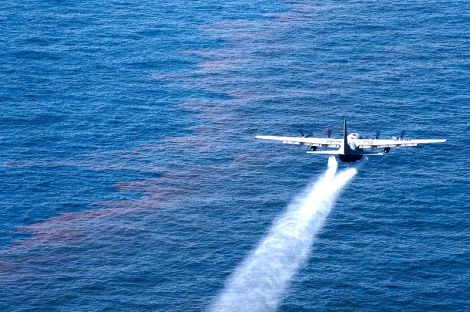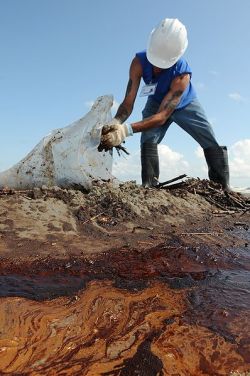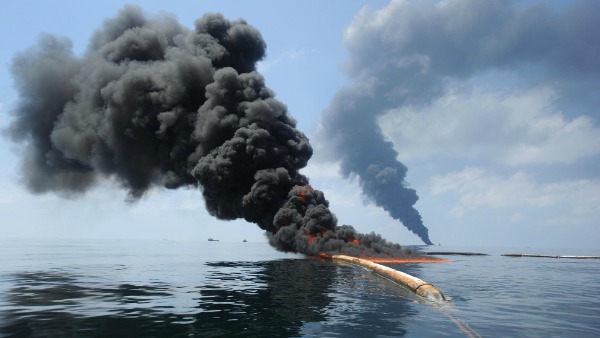
U.S. Air ForceA C-130 Hercules sprays Corexit onto the Gulf of Mexico.
“It’s as safe as Dawn dishwashing liquid.” That’s what Jamie Griffin says the BP man told her about the smelly, rainbow-streaked gunk coating the floor of the “floating hotel” where Griffin was feeding hundreds of cleanup workers during the BP oil disaster in the Gulf of Mexico. Apparently, the workers were tracking the gunk inside on their boots. Griffin, as chief cook and maid, was trying to clean it. But even boiling water didn’t work.
“The BP representative said, ‘Jamie, just mop it like you’d mop any other dirty floor,’” Griffin recalls in her Louisiana drawl.
It was the opening weeks of what everyone, echoing President Barack Obama, was calling “the worst environmental disaster in American history.” At 9:45 p.m. local time on April 20, 2010, a fiery explosion on the Deepwater Horizon oil rig had killed 11 workers and injured 17. One mile underwater, the Macondo well had blown apart, unleashing a gusher of oil into the gulf. At risk were fishing areas that supplied one-third of the seafood consumed in the U.S., beaches from Texas to Florida that drew billions of dollars’ worth of tourism to local economies, and Obama’s chances of reelection. Republicans were blaming him for mishandling the disaster, his poll numbers were falling, even his 11-year-old daughter was demanding, “Daddy, did you plug the hole yet?”
Griffin did as she was told: “I tried Pine-Sol, bleach, I even tried Dawn on those floors.” As she scrubbed, the mix of cleanser and gunk occasionally splashed onto her arms and face.
Within days, the 32-year-old single mother was coughing up blood and suffering constant headaches. She lost her voice. “My throat felt like I’d swallowed razor blades,” she says.
Then things got much worse.
Like hundreds, possibly thousands, of workers on the cleanup, Griffin soon fell ill with a cluster of excruciating, bizarre, grotesque ailments. By July, unstoppable muscle spasms were twisting her hands into immovable claws. In August, she began losing her short-term memory. After cooking professionally for 10 years, she couldn’t remember the recipe for vegetable soup; one morning, she got in the car to go to work, only to discover she hadn’t put on pants. The right side, but only the right side, of her body “started acting crazy. It felt like the nerves were coming out of my skin. It was so painful. My right leg swelled — my ankle would get as wide as my calf — and my skin got incredibly itchy.”
“These are the same symptoms experienced by soldiers who returned from the Persian Gulf War with Gulf War syndrome,” says Michael Robichaux, a Louisiana physician and former state senator, who treated Griffin and 113 other patients with similar complaints. As a general practitioner, Robichaux says he had “never seen this grouping of symptoms together: skin problems, neurological impairments, plus pulmonary problems.” Only months later, after Kaye H. Kilburn, a former professor of medicine at the University of Southern California and one of the nation’s leading environmental health experts, came to Louisiana and tested 14 of Robichaux’s patients did the two physicians make the connection with Gulf War syndrome, the malady that afflicted an estimated 250,000 veterans of that war with a mysterious combination of fatigue, skin inflammation, and cognitive problems.
Meanwhile, the well kept hemorrhaging oil. The world watched with bated breath as BP failed in one attempt after another to stop the leak. An agonizing 87 days passed before the well was finally plugged on July 15. By then, 210 million gallons of Louisiana sweet crude had escaped into the Gulf of Mexico, according to government estimates, making the BP disaster the largest accidental oil leak in world history.
Yet three years later, the BP disaster has been largely forgotten, both overseas and in the U.S. Popular anger has cooled. The media have moved on. Today, only the business press offers serious coverage of what the Financial Times calls “the trial of the century” — the trial now underway in New Orleans, where BP faces tens of billions of dollars in potential penalties for the disaster. As for Obama, the same president who early in the BP crisis blasted the “scandalously close relationship” between oil companies and government regulators two years later ran for reelection boasting about how much new oil and gas development his administration had approved.
Such collective amnesia may seem surprising, but there may be a good explanation for it: BP mounted a cover-up that concealed the full extent of its crimes from public view. This cover-up prevented the media and therefore the public from knowing — and above all, seeing — just how much oil was gushing into the gulf. The disaster appeared much less extensive and destructive than it actually was. BP declined to comment for this article.
That BP lied about the amount of oil it discharged into the gulf is already established. Lying to Congress about that was one of 14 felonies to which BP pleaded guilty last year in a legal settlement with the Justice Department that included a $4.5 billion fine, the largest fine ever levied against a corporation in the U.S.
What has not been revealed until now is how BP hid that massive amount of oil from TV cameras and the price that this “disappearing act” imposed on cleanup workers, coastal residents, and the ecosystem of the gulf. That story can now be told because an anonymous whistleblower has provided evidence that BP was warned in advance about the safety risks of attempting to cover up its leaking oil. Nevertheless, BP proceeded. Furthermore, BP appears to have withheld these safety warnings, as well as protective measures, both from the thousands of workers hired for the cleanup and from the millions of Gulf Coast residents who stood to be affected.
The financial implications are enormous. The trial now under way in New Orleans is wrestling with whether BP was guilty of “negligence” or “gross negligence” for the Deepwater Horizon disaster. If found guilty of “negligence,” BP would be fined, under the Clean Water Act, $1,100 for each barrel of oil that leaked. But if found guilty of “gross negligence”–which a cover-up would seem to imply — BP would be fined $4,300 per barrel, almost four times as much, for a total of $17.5 billion. That large a fine, combined with an additional $34 billion that the states of Louisiana, Alabama, Mississippi, and Florida are seeking, could have a powerful effect on BP’s economic health.
Yet the most astonishing thing about BP’s cover-up? It was carried out in plain sight, right in front of the world’s uncomprehending news media (including, I regret to say, this reporter).
The chief instrument of BP’s cover-up was the same substance that apparently sickened Jamie Griffin and countless other cleanup workers and local residents. Its brand name is Corexit, but most news reports at the time referred to it simply as a “dispersant.” Its function was to attach itself to leaked oil, break it into droplets, and disperse them into the vast reaches of the gulf, thereby keeping the oil from reaching Gulf Coast shorelines. And the Corexit did largely achieve this goal.
But the 1.84 million gallons of Corexit that BP applied during the cleanup also served a public-relations purpose: They made the oil spill all but disappear, at least from TV screens. By late July 2010, the Associated Press and The New York Times were questioning whether the spill had been such a big deal after all. Time went so far as to assert that right-wing talk-radio host Rush Limbaugh “has a point” when he accused journalists and environmentalists of exaggerating the crisis.
But BP had a problem: It had lied about how safe Corexit is, and proof of its dishonesty would eventually fall into the hands of the Government Accountability Project, the premiere whistleblower-protection group in the U.S. The proof? A technical manual BP had received from NALCO, the firm that supplied the Corexit that BP used in the gulf.
An electronic copy of that manual is included in a new report GAP has issued, “Deadly Dispersants in the Gulf.” On the basis of interviews with dozens of cleanup workers, scientists, and Gulf Coast residents, GAP concludes that the health impacts endured by Griffin were visited upon many other locals as well. What’s more, the combination of Corexit and crude oil also caused terrible damage to gulf wildlife and ecosystems, including an unprecedented number of seafood mutations; declines of up to 80 percent in seafood catch; and massive die-offs of the microscopic life-forms at the base of the marine food chain. GAP warns that BP and the U.S. government nevertheless appear poised to repeat the exercise after the next major oil spill: “As a result of Corexit’s perceived success, Corexit … has become the dispersant of choice in the U.S. to ‘clean up’ oil spills.”
BP’s cover-up was not planned in advance but devised in the heat of the moment as the oil giant scrambled to limit the PR and other damages of the disaster. Indeed, one of the chief scandals of the disaster is just how unprepared both BP and federal and state authorities were for an oil leak of this magnitude. U.S. law required that a response plan be in place before drilling began, but the plan was embarrassingly flawed.
“We weren’t managing for actual risk; we were checking a box,” says Mark Davis, director of the Institute on Water Resources Law and Policy at Tulane University. “That’s how we ended up with a response plan that included provisions for dealing with the impacts to walruses: because [BP] copied word for word the response plans that had been developed after the Exxon-Valdez oil spill [in Alaska, in 1989] instead of a plan tailored to the conditions in the gulf.”
As days turned into weeks and it became obvious that no one knew how to plug the gushing well, BP began insisting that Corexit be used to disperse the leaking oil. This triggered alarms from scientists and from a leading environmental NGO in Louisiana, the Louisiana Environmental Action Network (LEAN).
The group’s scientific adviser, Wilma Subra, a chemist whose work on environmental pollution had won her a “genius grant” from the MacArthur Foundation, told state and federal authorities that she was especially concerned about how dangerous the mixture of crude and Corexit was: “The short-term health symptoms include acute respiratory problems, skin rashes, cardiovascular impacts, gastrointestinal impacts, and short-term loss of memory,” she told GAP investigators. “Long-term impacts include cancer, decreased lung function, liver damage, and kidney damage.”
(Nineteen months after the Deepwater Horizon explosion, a scientific study published in the peer-reviewed journal Environmental Pollution found that crude oil becomes 52 times more toxic when combined with Corexit.)
BP even rebuffed a direct request from the administrator of the Environmental Protection Agency, Lisa Jackson, who wrote BP a letter on May 19, asking the company to deploy a less toxic dispersant in the cleanup. Jackson could only ask BP to do this; she could not legally require it. Why? Because use of Corexit had been authorized years before under the federal Oil Pollution Act.
In a recent interview, Jackson explains that she and other officials “had to determine, with less-than-perfect scientific testing and data, whether use of dispersants would, despite potential side effects, improve the overall situation in the gulf and coastal ecosystems. The tradeoff, as I have said many times, was potential damage in the deep water versus the potential for larger amounts of undispersed oil in the ecologically rich coastal shallows and estuaries.” She adds that the presidential commission that later studied the BP oil disaster did not fault the decision to use dispersants.
Knowing that EPA lacked the authority to stop it, BP wrote back to Jackson on May 20, declaring that Corexit was safe. What’s more, BP wrote, there was a ready supply of Corexit, which was not the case with alternative dispersants. (A NALCO plant was located just 30 miles west of New Orleans.)
But Corexit was decidedly not safe without taking proper precautions, as the manual BP got from NALCO spelled out in black and white. The “Vessel Captains Hazard Communication” resource manual, which GAP shared with me, looks innocuous enough. A three-ring binder with a black plastic cover, the manual contained 61 sheets, each wrapped in plastic, that detailed the scientific properties of the two types of Corexit that BP was buying, as well as their health hazards and recommended measures against those hazards.
BP applied two types of Corexit in the gulf. The first, Corexit 9527, was considerably more toxic. According to the NALCO manual, Corexit 9527 is an “eye and skin irritant. Repeated or excessive exposure … may cause injury to red blood cells (hemolysis), kidney or the liver.” The manual adds: “Excessive exposure may cause central nervous system effects, nausea, vomiting, anesthetic or narcotic effects.” It advises, “Do not get in eyes, on skin, on clothing,” and “Wear suitable protective clothing.”
When available supplies of Corexit 9527 were exhausted early in the cleanup, BP switched to the second type of dispersant, Corexit 9500. In its recommendations for dealing with Corexit 9500, the NALCO manual advised, “Do not get in eyes, on skin, on clothing,” “Avoid breathing vapor,” and “Wear suitable protective clothing.”
It’s standard procedure — and required by U.S. law — for companies to distribute this kind of information to any work site where hazardous materials are present so workers can know about the dangers they face and how to protect themselves. But interviews with numerous cleanup workers suggest that this legally required precaution was rarely if ever followed during the BP cleanup. Instead, it appears that BP told NALCO to stop including the manuals with the Corexit that NALCO was delivering to cleanup work sites.
“It’s my understanding that some manuals were sent out with the shipments of Corexit in the beginning [of the cleanup],” the anonymous source tells me. “Then, BP told NALCO to stop sending them. So NALCO was left with a roomful of unused binders.”
Roman Blahoski, NALCO’s director of global communications, says: “NALCO responded to requests for its pre-approved dispersants from those charged with protecting the gulf and mitigating the environmental, health, and economic impact of this event. NALCO was never involved in decisions relating to the use, volume, and application of its dispersant.”
Misrepresenting the safety of Corexit went hand in hand with BP’s previously noted lie about how much oil was leaking from the Macondo well. As reported by John Rudolf in The Huffington Post, internal BP emails show that BP privately estimated that “the runaway well could be leaking from 62,000 barrels a day to 146,000 barrels a day.” Meanwhile, BP officials were telling the government and the media that only 5,000 barrels a day were leaking.
In short, applying Corexit enabled BP to mask the fact that a much larger amount of oil was actually leaking into the gulf. “Like any good magician, the oil industry has learned that if you can’t see something that was there, it must have ‘disappeared,’” Scott Porter, a scientist and deep-sea diver who consults for oil companies and oystermen, says in the GAP report. “Oil companies have also learned that, in the public mind, ‘out of sight equals out of mind.’ Therefore, they have chosen crude oil dispersants as the primary tool for handling large marine oil spills.”
BP also had a more direct financial interest in using Corexit, argues Clint Guidry, president of the Louisiana Shrimp Association, whose members include not only shrimpers but fishermen of all sorts. As it happens, local fishermen constituted a significant portion of BP’s cleanup force (which numbered as many as 47,000 workers at the height of the cleanup). Because the spill caused the closure of their fishing grounds, BP and state and federal authorities established the Vessels of Opportunity (VoO) program, in which BP paid fishermen to take their boats out and skim, burn, and otherwise get rid of leaked oil. Applying dispersants, Guidry points out, reduced the total volume of oil that could be traced back to BP.
“The next phase of this trial [against BP] is going to turn on how much oil was leaked,” Guidry tells me. [If found guilty, BP will be fined a certain amount for each barrel of oil judged to have leaked.] “So hiding the oil with Corexit worked not only to hide the size of the spill but also to lower the amount of oil that BP may get charged for releasing.”

DVIDSHUBA contractor cleans up oily waste on Elmer’s Island, just west of Grand Isle, La., May 21, 2010.
Not only did BP fail to inform workers of the potential hazards of Corexit and to provide them with safety training and protective gear, according to interviews with dozens of cleanup workers, the company also allegedly threatened to fire workers who complained about the lack of respirators and protective clothing.
“I worked with probably a couple hundred different fishermen on the [cleanup],” Acy Cooper, Guidry’s second in command, tells me in Venice, the coastal town from which many VoO vessels departed. “Not one of them got any safety information or training concerning the toxic materials they encountered.” Cooper says that BP did provide workers with body suits and gloves designed for handling hazardous materials. “But when I’d talk with [the BP representative] about getting my guys respirators and air monitors, I’d never get any response.”
Roughly 58 percent of the 1.84 million gallons of Corexit used in the cleanup was sprayed onto the gulf from C-130 airplanes. The spray sometimes ended up hitting cleanup workers in the face.
“Our boat was sprayed four times,” says Jorey Danos, a 32-year-old father of three who suffered racking coughing fits, severe fatigue, and memory loss after working on the BP cleanup. “I could see the stuff coming out of the plane — like a shower of mist, a smoky color. I could see [it] coming at me, but there was nothing I could do.”
“The next day,” Danos continues, “when the BP rep came around on his speed boat, I asked, ‘Hey, what’s the deal with that stuff that was coming out of those planes yesterday?’ He told me, ‘Don’t worry about it.’ I said, ‘Man, that s–t was burning my face — it ain’t right.’ He said, ‘Don’t worry about it.’ I said, ‘Well, could we get some respirators or something, because that s–t is bad.’ He said, ‘No, that wouldn’t look good to the media. You got two choices: You can either be relieved of your duties or you can deal with it.’”
Perhaps the single most hazardous chemical compound found in Corexit 9527 is 2-Butoxyethanol, a substance that had been linked to cancers and other health impacts among cleanup workers on the 1989 Exxon-Valdez oil spill in Alaska. According to BP’s own data, 20 percent of offshore workers in the gulf had levels of 2-Butoxyethanol two times higher than the level certified as safe by the Occupational Safety and Health Administration.
Cleanup workers were not the only victims; coastal residents also suffered. “My 2-year-old grandson and I would play out in the yard,” says Shirley Tillman of the Mississippi coastal town Pass Christian. “You could smell oil and stuff in the air, but on the news they were saying it’s fine, don’t worry. Well, by October, he was one sick little fellow. All of a sudden, this very active little 2-year-old was constantly sick. He was having headaches, upper respiratory infections, earaches. The night of his birthday party, his parents had to rush him to the emergency room. He went to nine different doctors, but they treated just the symptoms; they’re not toxicologists.”
“It’s not the crime, it’s the cover-up.” Ever since the Watergate scandal of the 1970s, that’s been the mantra. Cover-ups don’t work, goes the argument. They only dig a deeper hole, because the truth eventually comes out.
But does it?
GAP investigators were hopeful that obtaining the NALCO manual might persuade BP to meet with them, and it did. On July 10, 2012, BP hosted a private meeting at its Houston offices. Presiding over the meeting, which is described here publicly for the first time, was BP’s public ombudsman, Stanley Sporkin, joining by telephone from Washington. Ironically, Sporkin had made his professional reputation during the Watergate scandal. As a lawyer with the Securities and Exchange Commission, Sporkin investigated illegal corporate payments to the slush fund that President Nixon used to buy the silence of the Watergate burglars.
Also attending the meeting were two senior BP attorneys; BP Vice President Luke Keller; other BP officials; Thomas Devine, GAP’s senior attorney on the BP case; Shanna Devine, GAP’s investigator on the case; Michael Robichaux; Wilma Subra; and Marylee Orr, the executive director of LEAN. The following account is based on my interviews with Thomas Devine, Robichaux, Subra, and Orr. BP declined to comment.
BP officials had previously confirmed the authenticity of the NALCO manual, says Thomas Devine, but now they refused to discuss it, even though this had been one of the stated purposes for the meeting. Nor would BP address the allegation, made by the whistleblower who had given the manual to GAP, that BP had ordered the manual withheld from cleanup work sites, perhaps to maintain the fiction that Corexit was safe.
“They opened the meeting with this upbeat presentation about how seriously they took their responsibilities for the spill and all the wonderful things they were doing to make things right,” says Devine. “When it was my turn to speak, I said that the manual our whistleblower had provided contradicted what they just said. I asked whether they had ordered the manual withdrawn from work sites. Their attorneys said that was a matter they would not discuss because of the pending litigation on the spill.” [Disclosure: Thomas Devine is a friend of this reporter.]
The visitors’ top priority was to get BP to agree not to use Corexit in the future. Keller said that Corexit was still authorized for use by the U.S. government and BP would indeed feel free to use it against any future oil spills.
A second priority was to get BP to provide medical treatment for Jamie Griffin and the many other apparent victims of Corexit-and-crude poisoning. This request too was refused by BP.
Robichaux doubts his patients will receive proper compensation from the $7.8 billion settlement BP reached in 2012 with the Plaintiffs’ Steering Committee, 19 court-appointed attorneys who represent the hundreds of individuals and entities that have sued BP for damages related to the gulf disaster. “Nine of the most common symptoms of my patients do not appear on the list of illnesses that settlement says can be compensated, including memory loss, fatigue, and joint and muscular pain,” says Robichaux. “So how are the attorneys going to file suits on behalf of those victims?”
At one level, BP’s cover-up of the gulf oil disaster speaks to the enormous power that giant corporations exercise in modern society, and how unable, or unwilling, governments are to limit that power. To be sure, BP has not entirely escaped censure for its actions; depending on the outcome of the trial now under way in New Orleans, the company could end up paying tens of billions of dollars in fines and damages over and above the $4.5 billion imposed by the Justice Department in the settlement last year. But BP’s reputation appears to have survived: Its market value as this article went to press was a tidy $132 billion, and few, if any, BP officials appear likely to face any legal repercussions. “If I would have killed 11 people, I’d be hanging from a noose,” says Jorey Danos. “Not BP. It’s the golden rule: The man with the gold makes the rules.”
As unchastened as anyone at BP is Bob Dudley, the American who was catapulted into the CEO job a few weeks into the gulf disaster to replace Tony Hayward, whose propensity for imprudent comments — “I want my life back,” the multimillionaire had pouted while thousands of gulf workers and residents were suffering — had made him a globally derided figure. Dudley told the annual BP shareholders meeting in London last week that Corexit “is effectively … dishwashing soap,” no more toxic than that, as all scientific studies supposedly showed. What’s more, Dudley added, he himself had grown up in Mississippi and knows that the Gulf of Mexico is “an ecosystem that is used to oil.”
Nor has the BP oil disaster triggered the kind of changes in law and public priorities one might have expected. “Not much has actually changed,” says Mark Davis of Tulane. “It reflects just how wedded our country is to keeping the Gulf of Mexico producing oil and bringing it to our shores as cheaply as possible. Going forward, no one should assume that just because something really bad happened we’re going to manage oil and gas production with greater sensitivity and wisdom. That will only happen if people get involved and compel both the industry and the government to be more diligent.”
And so the worst environmental disaster in U.S. history has been whitewashed — its true dimensions obscured, its victims forgotten, its lessons ignored. Who says cover-ups never work?




